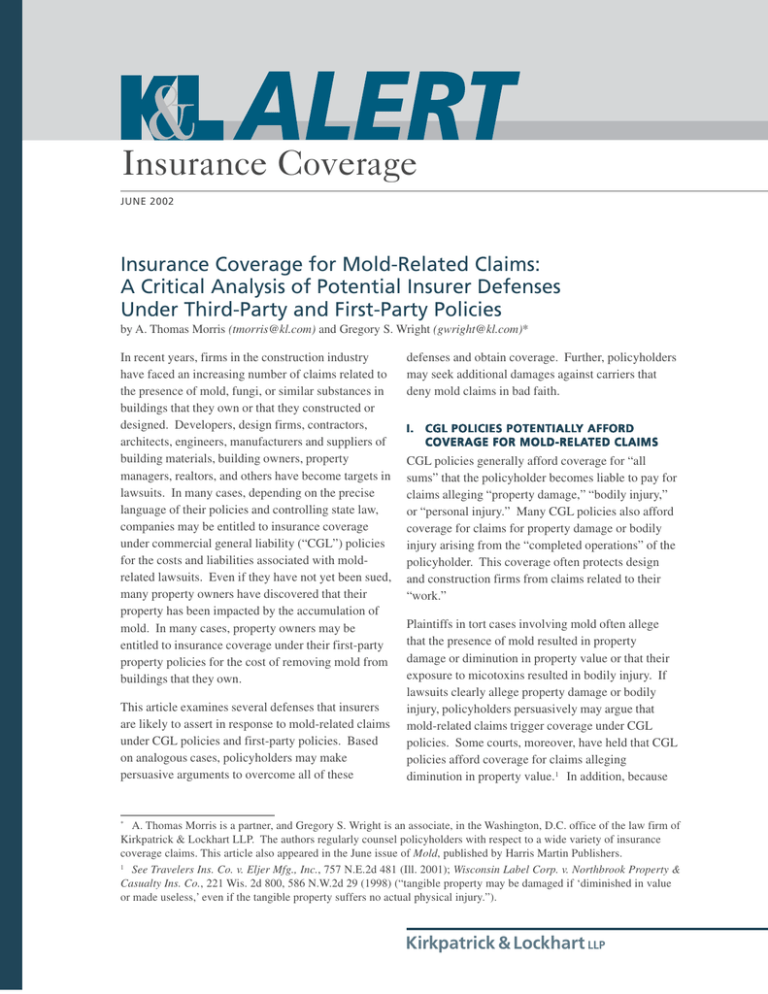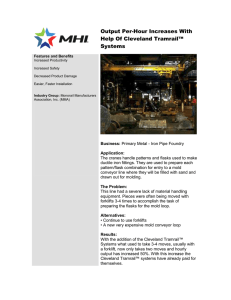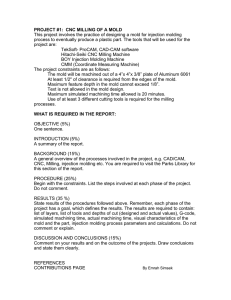
Insurance Coverage
JUNE 2002
Insurance Coverage for Mold-Related Claims:
A Critical Analysis of Potential Insurer Defenses
Under Third-Party and First-Party Policies
by A. Thomas Morris (tmorris@kl.com) and Gregory S. Wright (gwright@kl.com)*
In recent years, firms in the construction industry
have faced an increasing number of claims related to
the presence of mold, fungi, or similar substances in
buildings that they own or that they constructed or
designed. Developers, design firms, contractors,
architects, engineers, manufacturers and suppliers of
building materials, building owners, property
managers, realtors, and others have become targets in
lawsuits. In many cases, depending on the precise
language of their policies and controlling state law,
companies may be entitled to insurance coverage
under commercial general liability (“CGL”) policies
for the costs and liabilities associated with moldrelated lawsuits. Even if they have not yet been sued,
many property owners have discovered that their
property has been impacted by the accumulation of
mold. In many cases, property owners may be
entitled to insurance coverage under their first-party
property policies for the cost of removing mold from
buildings that they own.
This article examines several defenses that insurers
are likely to assert in response to mold-related claims
under CGL policies and first-party policies. Based
on analogous cases, policyholders may make
persuasive arguments to overcome all of these
defenses and obtain coverage. Further, policyholders
may seek additional damages against carriers that
deny mold claims in bad faith.
I.
CGL POLICIES POTENTIALL
Y AFFORD
POTENTIALLY
COVERAGE FOR MOLD-RELA
TED CLAIMS
MOLD-RELATED
CGL policies generally afford coverage for “all
sums” that the policyholder becomes liable to pay for
claims alleging “property damage,” “bodily injury,”
or “personal injury.” Many CGL policies also afford
coverage for claims for property damage or bodily
injury arising from the “completed operations” of the
policyholder. This coverage often protects design
and construction firms from claims related to their
“work.”
Plaintiffs in tort cases involving mold often allege
that the presence of mold resulted in property
damage or diminution in property value or that their
exposure to micotoxins resulted in bodily injury. If
lawsuits clearly allege property damage or bodily
injury, policyholders persuasively may argue that
mold-related claims trigger coverage under CGL
policies. Some courts, moreover, have held that CGL
policies afford coverage for claims alleging
diminution in property value.1 In addition, because
*
A. Thomas Morris is a partner, and Gregory S. Wright is an associate, in the Washington, D.C. office of the law firm of
Kirkpatrick & Lockhart LLP. The authors regularly counsel policyholders with respect to a wide variety of insurance
coverage claims. This article also appeared in the June issue of Mold, published by Harris Martin Publishers.
1
See Travelers Ins. Co. v. Eljer Mfg., Inc., 757 N.E.2d 481 (Ill. 2001); Wisconsin Label Corp. v. Northbrook Property &
Casualty Ins. Co., 221 Wis. 2d 800, 586 N.W.2d 29 (1998) (“tangible property may be damaged if ‘diminished in value
or made useless,’ even if the tangible property suffers no actual physical injury.”).
Kirkpatrick & Lockhart LLP
many plaintiffs allege that the presence of mold
forced them to evacuate their property, policyholders
persuasively may argue that mold-related claims
trigger coverage under the personal injury coverage
part commonly found in CGL policies, which covers
claims alleging “wrongful eviction” or “interference
with the private right of occupancy.”
Insurers have and likely will continue to assert
numerous defenses to mold-related claims. The
following chart briefly summarizes several of those
POTENTIAL INSURER DEFENSES
defenses and indicates how policyholders and/or
courts have responded to the defenses. This article
then focuses on the following two defenses in more
detail: (1) the pollution exclusion defense, and
(2) the “expected or intended” defense. Finally, this
article examines additional damages that may be
available to policyholders if insurers deny mold
claims in bad faith.
RESPONSE OF POLICYHOLDERS
AND/OR COURTS
The “Business Risk” Exclusion Defense
Insurers may deny coverage on the basis of certain
“business risk” exclusions, one form of which
generally bars coverage for a policyholder’s own
work or own product.
Courts generally hold that many forms of business
risk exclusions bar coverage only for the
replacement cost of a defective product itself, at
most, but do not bar coverage for the cost of labor,
repair, or other associated costs. In addition, the
exclusions typically do not bar coverage for, among
other things, claims alleging that the policyholder’s
defective product or defective work caused
additional property damage or bodily injury.2
Thus, even assuming arguendo that a business risk
exclusion prevented a contractor from recovering
for the cost of repairing a roof that it installed
improperly, the exclusion arguably would not bar
coverage for mold-related damage that resulted
from the leaking roof.3
2
3
See Peter Kalis, Policyholder’s Guide to Insurance Coverage, §10.02[B].
Radenbaugh v. Farm Bureau General Ins. Co., 610 N.W.2d 272 (Mich. Ct. App. 2000).
Kirkpatrick & Lockhart LLP
2
POTENTIAL INSURER DEFENSES
RESPONSE OF POLICYHOLDERS
AND/OR COURTS
Trigger-Related Defenses
When a loss occurs continuously over several
policy periods, a court must decide which of the
policies are potentially “triggered.” In cases arising
in the context of environmental and asbestos
claims, courts have adopted a variety of “trigger”
theories (see adjacent column). Based on the facts
of a specific claim, and applicable trigger law, an
insurer may deny a claim on the grounds that its
policy is not “triggered” because the injury at issue
purportedly did not take place during the policy
period.
Depending on the facts of a particular claim, a
variety of trigger positions may apply in the context
of mold claims:
Exposure Trigger (if a claimant was exposed
to mold during multiple policy periods, then
all policies in effect during the entire period
of “exposure” would be triggered).4
Initial Exposure Trigger (only the policy in
effect when the plaintiff was first “exposed”
to the mold would be triggered).5
Installation Trigger (policy in effect on date
of installation of defective product is
triggered).6
Manifestation Trigger (only the policy in
effect when the plaintiff’s injuries first
became known or “manifest” would be
triggered).7
Continuous Trigger (all policies in effect from
the date of the initial exposure to the mold
through the manifestation of the alleged
injuries would be triggered).8
Mold Exclusions
Insurers sporadically are attempting to add moldrelated exclusions to CGL policies, although it does
not appear that the insurance industry has
developed a standard form.9
Coverage will vary depending on the precise terms
of any valid and applicable exclusion. Courts have
not yet had a chance to interpret mold exclusions in
CGL policies.
Insurers generally are not entitled to modify
existing policies without sufficient consideration
and generally may not add exclusions retroactively.
4
Cole v. Celotex Corp., 599 So. 2d 1058 (La. 1992). See generally John M. Sylvester and John T. Waldron, III,
Insurance Coverage for Damage Caused by Mold and Fungus Infestation, Construction Law and Business, at 47, 49
(Summer 2000)(discussing trigger issues).
5
Eljer Mfg., Inc. v. Liberty Mutual Ins. Co., 972 F.2d 805 (7th Cir. 1992)(holding that coverage is triggered as of the
date of installation of defective product into a building).
6
Eljer, 972 F.2d 805.
7
Eagle-Picher Indus., Inc. v. Liberty Mutual Ins. Co., 682 F.2d 12 (1st Cir. 1982), cert. denied, 460 U.S. 1028 (1983).
8
J.H. France Refractories Co. v. Allstate Ins. Co., 626 A.2d 502 (Pa. 1993).
9
Patrick J. Wielinski, Third Party Insurance for Mold Claims, 11 Coverage 21 (Nov./Dec. 2001), at 21.
Kirkpatrick & Lockhart LLP
3
The Pollution Exclusion Defense
Insurers may argue that mold is a type of pollutant
and, therefore, falls within the scope of an exclusion
barring coverage for certain pollution-related claims.
Over the years, CGL insurers have used various
forms of the pollution exclusion. For purposes of
illustration, one version of the pollution exclusion
bars coverage for bodily injury and property damage
claims:
arising out of the discharge, dispersal, release
or escape of smoke, vapors, soot, fumes,
acids, alkalis, toxic chemicals, oil, or other
petroleum substances or derivatives
(including any oil refuse or oil mixed with
waste), liquids or gases, waste materials or
other irritants, contaminants or pollutants into
or upon land, the atmosphere or any water
course or body of water).
Several courts have rejected the application of the
pollution exclusion to mold-related claims. For
example, in Stillman v. Charter Oak Fire Ins. Co.,10
a federal district court in Florida held that the
pollution exclusion was ambiguous and, thus, did not
apply to a claim filed by office workers allegedly
exposed to mold emitted by a defective HVAC
system.
In addition, policyholders may contest the
applicability of the pollution exclusion to moldrelated claims for other reasons. First, certain
pollution exclusions do not apply to claims arising
from “completed operations.”11 Thus, to the extent
that a complaint seeks damages from a contractor or
design firm related to buildings that have been
completed, the pollution exclusion may not apply at
all.
Second, the pollution exclusion arguably applies only
to claims involving industrial environmental
pollution, rather than claims involving damage to
buildings and homes, such as mold-related claims.
For example, in holding that the pollution exclusion
did not apply to a claim arising from the release of
carbon monoxide fumes in a building, one court
reasoned that the “history of the pollution exclusion
indicates” that it should be applied only to traditional
environmental litigation claims.12
Third, mold and fungi arguably are not “irritants,
contaminants, or pollutants,” as those terms are used
in the pollution exclusion. In analogous cases, courts
have held that the exclusion did not apply to
substances that naturally occur in the environment,
such as bacteria13 or carbon monoxide.14
Fourth, mold-related claims arguably do not involve
a “discharge, dispersal, release, or escape” of
pollutants into the environment. Courts have
reasoned that the terms “discharge,” “dispersal,”
“release,” and “escape” are “terms of art in
environmental law which generally are used with
reference to damage or injury caused by improper
disposal or containment of hazardous waste.”15
Based on this reasoning, one court held that the
pollution exclusion did not apply to a mold-related
claim because “no contaminants were released, but
rather formed over time” inside the walls of a
building.16 For similar reasons, certain courts have
held that the pollution exclusion does not apply to
claims involving indoor emissions.17
The “Expected or Intended” Defense
CGL policies generally bar coverage for claims for
property damage or bodily injury that is “expected or
intended from the standpoint of the insured.”
10
No. 1949-CV-Highsmith (S.D. Fla. June 18, 1993), rev’d on procedural grounds, 88 F.3d 911 (11th Cir. 1996).
See West American Ins. Co. v. Tufco Flooring East, Inc., 104 N.C. App. 312, 409 S.E.2d 692 (1991).
12
Western Alliance Ins. Co. v. Gill, 686 N.E.2d 997, 999 (Mass. 1997).
13
Keggi v. Northbrook Prop. & Cas. Ins. Co., 13 P.3d 785 (Ariz. 2000).
14
Donaldson v. Urban Land Interests, Inc., 564 N.W.2d 728 (Wis. 1997).
15
Essex Ins. Co., Inc. v. Berkshire Envtl. Consultants, Inc., No. 99-30280-FHF, slip op. at 7 (D. Mass. 2002), reprinted
in Mealey’s Litigation Reports: Insurance (Feb. 12, 2002).
16
Leverence v. United States Fid. & Guar., 158 Wis. 2d 64, 97, 462 N.W.2d 218, 232 (1990)(emphasis added).
17
See Stoney Run Co. v. Prudential-LMI Commercial Ins. Co., 47 F.3d 34 (2d Cir. 1995); American States Ins. Co. v.
Koloms, 177 Ill. 2d 473, 687 N.E.2d 72 (1997).
11
Kirkpatrick & Lockhart LLP
4
Insurers may attempt to deny coverage on the ground
that companies knew or should have known about the
presence of mold in their buildings. Courts,
however, have placed several restrictions on the
“expected or intended” defense. To prevail, an
insurer may need to prove that the policyholder
actually knew about the mold at issue; proof that the
policyholder should have known or that a reasonable
policyholder would have discovered the mold may
not defeat coverage.18 In addition, an insurer may
need to prove that the policyholder subjectively
expected or intended the specific property damage or
bodily injury at issue in the claim.19 Proof that the
policyholder was aware of mold in one area of a
building may not defeat coverage arising from the
existence of mold in another area of the building.
Similarly, proof that the policyholder was aware of
mold produced by a HVAC system may not defeat
coverage for mold produced by a leaking foundation.
II. FIRST
-PAR
TY PROPER
TY POLICIES
FIRST-PAR
-PARTY
PROPERTY
POTENTIALL
Y AFFORD COVERAGE FOR
POTENTIALLY
MOLD-RELA
TED LOSSES
MOLD-RELATED
Many property owners have discovered the presence
of mold in their buildings or homes. If left
unchecked, the presence of mold in the building may
lead to a sharp decrease in the value of the property
or may expose the occupants of the buildings to
harmful micotoxins. Thus, property owners often
must incur substantial costs to remove mold from
their property. In many cases, property owners may
recover this cost from their first-party insurers.
Many first-party property policies contain the
following insuring agreement:
Except as hereinafter excluded this policy
insures against all risks of direct physical loss
of or damage to the property insured.
18
19
20
21
22
23
24
25
Courts have held that “all risk” policies create a
“special type of coverage extending to risks not
usually covered under other insurance” and should,
therefore, be interpreted broadly.20
In the context of first-party policies, insurers may
assert several defenses to coverage for mold-related
claims. First, insurers may argue that mold-related
claims are not covered because commercial property
companies purportedly knew about specific water
problems or generally have known about the issue of
mold for years and, therefore, the losses are not
“fortuitous.” Although first-party policies do not
contain the word “fortuitous,” some courts have held
that “all risk” policies cover only “fortuitous”
losses—that is, losses that were “not certain to
occur”21 or were “dependent on chance.”22 The
majority of courts, however, have interpreted the
“fortuity” defense narrowly, holding that “fortuity”
must be measured from the subjective viewpoint of
the policyholder at the time the policy was issued.23
In other words, a court must ask whether the
policyholder knew of the specific mold-related loss
at issue on the inception date of the policy. The fact
that the policyholder was aware that mold claims
were becoming more common or that it faced some
risk of mold-related damage in the future does not
defeat coverage.24 Similarly, the fact that in
hindsight one might conclude that a reasonable
policyholder should have known of the risks of mold
does not defeat coverage.25
In addition, insurers may deny coverage on the
grounds of various exclusions in first-party policies,
including exclusions that bar coverage for losses
arising from “design defects” or “faulty
workmanship.” Insurers may argue that because
mold damage arises from flaws in the design or
construction of a building, there is no coverage.
Vermont Mut. Ins. Co. v. Singleton, 446 S.E.2d 417 (S.C. 1994).
United States Fid. & Guar. Co. v. Armstrong, 479 So. 2d 1164, 1167 (Ala. 1985).
See Texas Eastern Transmission Corp. v. Marine Office-Appleton & Cox Corp., 579 F.2d 561, 564 (10th Cir. 1978).
Avis v. Hartford Fire Ins. Co., 195 S.E.2d 545, 548 (N.C. 1973).
Insurance Co. of N. Am. v. U.S. Gypsum Co., 870 F.2d 148, 151 (4th Cir. 1989).
See Compagnie des Bauxites v. Ins. Co. of N. Am., 724 F.2d 369, 372 (3d Cir. 1983).
U.S. Gypsum Co., 870 F.2d at 151.
See Compagnie des Bauxites, 724 F.2d at 372.
Kirkpatrick & Lockhart LLP
5
In response, policyholders may argue that the
exclusions do not apply because there is no “design
defect” or “faulty workmanship.” The mere fact that
a roof or wall leaks does not necessarily prove the
existence of a “design defect.” To the contrary,
numerous other factors may have contributed to the
presence of mold in the building, such as rain,
floods, or problems with the materials used to
construct the building. In addition, design defect
and faulty workmanship exclusions often contain
“ensuing loss” provisions that restore coverage for
losses that arise from the design defect or faulty
workmanship. For example, many courts have held
that when a defective piece of property threatens
other insured property, the ensuing loss provision
restores coverage.26
In addition, certain first-party policies may contain
an exclusion barring coverage for “mold or other
fungi.” Depending on the precise language of the
mold exclusion, however, policyholders may still
obtain coverage for certain mold-related claims. For
example, certain exclusions bar coverage for
damage caused by “mold or other fungi,” but
contain an exception restoring coverage for “ensuing
loss caused by water damage … if the loss would
otherwise be covered under the policy.” Based on
this “ensuing loss” provision, one court held that a
policy afforded coverage for claims for mold-related
damage that arose from water damage caused by a
leaking roof. The court reasoned that the “mold that
followed the water damage was caused by water
damage. Therefore, under the facts of the case, the
exclusion for fungi and mold does not apply.”27
III. POTENTIAL BAD-FAITH DAMAGES
As noted above, insurers may assert several types of
defenses to mold-related claims under both thirdparty and first-party insurance policies. The
willingness of insurers to assert questionable
defenses may be tempered in light of several recent
decisions involving multi-million dollar awards to
policyholders due to the insurers’ bad-faith handling
of mold claims. For example, in Hatley v. CenturyNational Ins. Co.,28 a jury in Arizona recently
awarded $4 million in punitive damages based on
allegations that the insurer delayed handling the
claim.29
IV
IV.. CONCLUSION
Depending on the precise terms of their policies,
policyholders often have strong arguments to obtain
insurance coverage for mold-related lawsuits and/or
to pay to remove mold from their own property. For
business planning purposes, companies involved in
the construction and design industries should
carefully review their insurance policies for potential
coverage for mold-related claims.
26
See Schloss v. Cincinnati Ins. Co., 54 F. Supp.2d 1090, 1096 (M.D. Ala. 1999); National Fire Ins. Co. of Pittsburgh,
Pennsylvania v. Valero Energy Corp., 777 S.W.2d 501, 506 (Tex. App. 1989).
27
Home Ins. Co. v. McClain, No. 05-97-01479-CV, slip op. at 2 (Tex. Ct. App. Feb. 10, 2000), reprinted in Mealey’s
Emerging Insurance Disputes (Feb. 25, 2000).
28
No. CV 2000-006713 (Ariz. Super. Ct., Maricopa County)(Nov. 24, 2001).
29
See also Ballard v. Farmers Ins. Exchange, No. 99-05252 (Tex. Dist. Ct., Travis County, 345th Judicial District)
(June 1, 2001)(jury awarded a married couple a judgment of $32 million against its homeowners insurer); Anderson v.
Allstate Ins. Co., No. CIV-00-907 (E.D. Cal. 2000)($18 million awarded to homeowner in mold coverage action),
reprinted in Mealey’s Emerging Insurance Disputes, Nov. 22, 2000.
Kirkpatrick & Lockhart LLP
6
The Insurance Coverage practice group at Kirkpatrick & Lockhart LLP is one of the nation’s largest
policyholder-oriented practices. Its attorneys have authored Policyholder’s Guide to the Law of
Insurance Coverage and edited the Journal of Insurance Coverage.
For additional information concerning this topic or Kirkpatrick & Lockhart LLP’s insurance coverage
practice, please consult the Kirkpatrick & Lockhart LLP office contacts listed below:
Boston
Dallas
Harrisburg
Los Angeles
Miami
Newark
NewYork
Pittsburgh
John M. Edwards
Robert Everett Wolin
Raymond P. Pepe
David P. Schack
Daniel A. Casey
Anthony La Rocco
Eugene R. Licker
Thomas M. Reiter
John M. Sylvester
Edward Sangster
David T. Case
Matthew L. Jacobs
Philip H. Hecht
A. Thomas Morris
San Francisco
Washington
617.261.3123
214.939.4909
717.231.5988
310.552.5061
305.539.3324
973.848.4014
212.536.3916
412.355.8274
412.355.8617
415.249.1028
202.778.9084
202.778.9393
202.778.9380
202.778.9376
jedwards@kl.com
rwolin@kl.com
rpepe@kl.com
dschack@kl.com
dcasey@kl.com
alarocco@kl.com
elicker@kl.com
treiter@kl.com
jsylvester@kl.com
esangster@kl.com
dcase@kl.com
mjacobs@kl.com
phecht@kl.com
tmorris@kl.com
®
Kirkpatrick & Lockhart LLP
Challenge us.
®
www.kl.com
BOSTON
DALLAS
HARRISBURG
LOS ANGELES
MIAMI
NEWARK
NEW YORK
PITTSBURGH
SAN FRANCISCO
WASHINGTON
.........................................................................................................................................................
This publication/newsletter is for informational purposes and does not contain or convey legal advice. The information herein
should not be used or relied upon in regard to any particular facts or circumstances without first consulting a lawyer.
© 2002 KIRKPATRICK & LOCKHART LLP.
ALL RIGHTS RESERVED.





